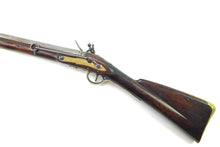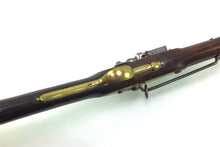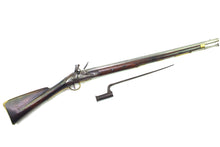
A Rare Pattern 1799 Eliott Flintlock Carbine. 10th Light Dragoons.
Missed out on this item? Click to view all current Antique Muskets, Rifles & Sporting Guns Free UK delivery on all items
43 ½” overall, 28” round carbine bore barrel with Government proofs at the breech. India pattern carbine lock with border engraving. Crown ‘GR’ and inspector’s mark and ‘Tower’ across the tail. Border engraved swan neck cock with storekeeper’s marks and board of ordinance marks in the butt. Regulation brass mounts, butt plate tang engraved ‘E/45 10th LD’, sporting gun sideplate, sling bar swivel and ramrod with a swell. Original 13” socket bayonet by Osbourn.
Circa 1800.
In very good condition
10th Light Dragoons:
In 1804, Napoleon Bonaparte had 200,000 men and a fleet of flat-bottomed barges held in readiness at Boulogne for an invasion of England, and the establishment of the 10th Light Dragoons was increased to 10 troops, stationed in southern England. (Napoleon's plans were thwarted by Nelson's victory at Trafalgar in 1805).
In 1806 the Regiment followed a fashion common throughout European cavalry and was designated "hussars", with variations to the uniform and an augmentation to the title which became the 10th Prince of Wales's Own Light Dragoons (Hussars).
In November 1808, the years of comparative peace ended when the Regiment embarked for war in Portugal, under command of Lt. Col. George Leigh with an establishment of 8 Troops, each with 3 officers and 90 other ranks plus horses. Arriving at Corunna, the horses were winched into the sea where they swam to shore. The Regiment joined the army commanded by Lt. Gen. Sir John Moore at Zamora.
To General Moore's surprise, there were no Spanish allies waiting to support his army of 25,000 British troops against the entire French army of 300,000 regular troops. Nevertheless, Moore advanced and the 10th Hussars, together with the 15th Hussars, fought a major engagement at Sahagun in December and another shortly thereafter at Majorga, both of which were successful. At the approach of the main body of the French, under command of the Emperor himself, the British retreated to Corunna with the cavalry acting as rear-guard. Many valiant actions are recorded in this respect. Apart from the French, the winter conditions were particularly arduous with 1 officer and 17 privates dying of fatigue, and 60 horses dying in the snow.
In January 1809 the British re-embarked at Corunna, leaving behind the majority of the horses and their commander, General Moore, who had been killed during the retreat. The Regiment rested in the area of London and both men and horses were recruited to bring the Regiment back to strength. On the appointment of the Prince of Wales as regent for the (demented) King, the title of the Regiment was changed to the 10th, Prince of Wales's Own, Royal Regiment of Hussars. In 1812 the Regiment undertook ceremonial duties at Knightsbridge Barracks in London.
In January 1813, the Regiment returned to Portugal, where the British fortunes had changed. Taking advantage of Napoleon's ill-fated invasion of Russia, Wellington's army in Spain seized the initiative and defeated the French in a long campaign which was drawing to a close in 1813. Pursuing the retreating French forces, the Regiment operated in mountainous country with a major engagement at Morales in June, and later that month they fought the Battle of Vitoria, which sealed the fate of the French army in Spain. In December, Wellington's army entered France.
The Regiment took part in continuous harassment of the French withdrawal and fought the major battle of Toulouse in April 1814. Shortly thereafter, Napoleon conceded defeat. The Regiment returned to England in July, at which time they were stationed in Brighton. The establishment was reduced from 12 troops to 8. In March 1815, they were required to suppress riots in London (relating to the introduction of Corn Laws which raised food prices).
On Napoleon's resurgence in April 1815, the Regiment re-embarked for France (leaving a depot squadron at Brighton) where they joined the brigade commanded by Maj. Gen. Sir Hussey Vivian in Wellington's army. A night march took the 10th Hussars to the proximity of Brussels just as the Prussian allies were defeated at Ligny and British troops were engaged at Quatre Bras. On 17th July the heavens opened with a thunderous storm which quickly turned the fields to mud. After an uncomfortable night, the Regiment was positioned on the left of the British line in front of the village of Waterloo. Mid-morning, the Regiment was ordered to support the centre of the British line where the infantry squares were sorely pressed:
"So dense was the smoke that the noise of the approaching enemy was often heard before any object could be distinguished . . the roar of four hundred cannon, the volleys of musketry and the impetuous noise and shouts of the soldiery producing a scene of carnage and confusion impossible to describe. "
Passing between the infantry squares, the Regiment twice charged the advancing French. The charges were successful, but at huge cost with 2 officers, 19 privates and 51 horses killed and 6 officers (including the Commanding Officer, Col. Quentin), 24 other ranks and numerous horses wounded or missing. (Later, all ranks were issued with a silver medal and two years' service credit). The Regiment entered Paris in July. Returning to England in January 1816













